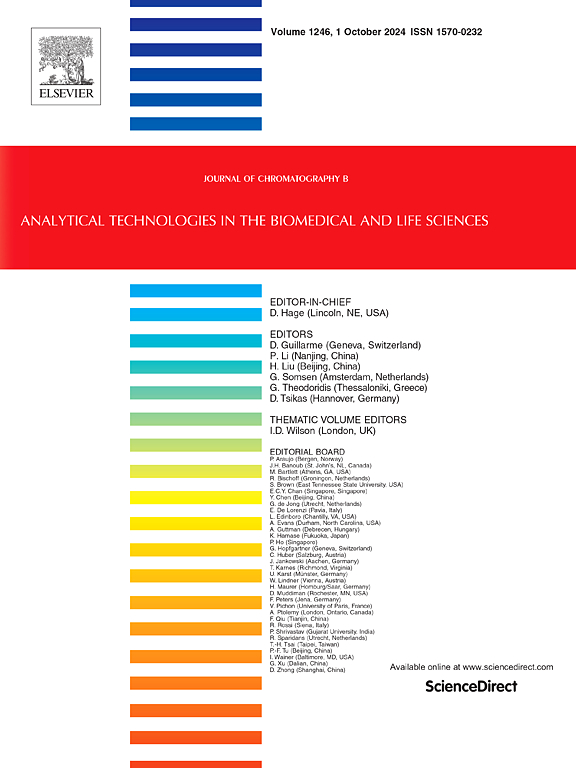评估与二十二碳六烯酸结合在 sn-1 或 sn-2 位置的磷脂酰胆碱位置异构体的电离效率。
IF 2.8
3区 医学
Q2 BIOCHEMICAL RESEARCH METHODS
引用次数: 0
摘要
磷脂酰胆碱(PC)是一种重要的磷脂,它含有两种脂肪酸,可分别结合在 sn-1 和 sn-2 位上,当连接不同的脂肪酸时会产生位置异构体。目前,还没有一种成熟的方法可以利用每种 PC 异构体的真品标准来鉴别磷脂分子种类和量化单个异构体。在本研究中,我们通过化学合成和制备纯化的方法制备了 PC 位置异构体的真实分析标准物质。这些异构体含有连接在 sn-1 和 sn-2 位置的二十二碳六烯酸(DHA,22:6)和棕榈酸(16:0),分别称为 PC(22:6/16:0) 和 PC(16:0/22:6)。采用液相色谱-串联质谱法分析了 PC(22:6/16:0) 和 PC(16:0/22:6) 的标准溶液,并绘制了 PC 位置异构体的校准曲线,以比较它们的电离效率。PC(22:6/16:0) 的电离效率是 PC(16:0/22:6) 的 2.32 倍,表明电离效率取决于脂肪酸的结合位置。阐明并纠正 PC 位置异构体电离效率的差异将有助于今后对脂质体进行精确的定量分析。本文章由计算机程序翻译,如有差异,请以英文原文为准。
Evaluation of the ionization efficiency in phosphatidylcholine positional isomers with docosahexaenoic acid bound to the sn-1 or sn-2 position
Phosphatidylcholine (PC), a key phospholipid, contains 2 fatty acids that can be bound at the sn-1 and sn-2 positions, resulting in positional isomers when different fatty acids are attached. Currently, there is no established method for identifying phospholipid molecular species and quantifying individual isomers using authentic standards of each PC isomer. In this study, we prepare authentic analytical standards for PC positional isomers through chemical synthesis and preparative purification. These isomers contain docosahexaenoic acid (DHA, 22:6) and palmitic acid (16:0) attached at the sn-1 and sn-2 positions and are denoted as PC(22:6/16:0) and PC(16:0/22:6), respectively. Standard solutions of PC(22:6/16:0) and PC(16:0/22:6) were analyzed using liquid chromatography-tandem mass spectrometry, and calibration curves of the PC positional isomers were generated to compare their ionization efficiencies. The ionization efficiency of PC(22:6/16:0) was 2.32 times higher than that of PC(16:0/22:6), indicating that the ionization efficiency depends on the binding position of the fatty acid. Elucidating and correcting the differences in the ionization efficiencies of the PC positional isomers will enable the accurate quantitative analysis of lipidomes in the future.
求助全文
通过发布文献求助,成功后即可免费获取论文全文。
去求助
来源期刊

Journal of Chromatography B
医学-分析化学
CiteScore
5.60
自引率
3.30%
发文量
306
审稿时长
44 days
期刊介绍:
The Journal of Chromatography B publishes papers on developments in separation science relevant to biology and biomedical research including both fundamental advances and applications. Analytical techniques which may be considered include the various facets of chromatography, electrophoresis and related methods, affinity and immunoaffinity-based methodologies, hyphenated and other multi-dimensional techniques, and microanalytical approaches. The journal also considers articles reporting developments in sample preparation, detection techniques including mass spectrometry, and data handling and analysis.
Developments related to preparative separations for the isolation and purification of components of biological systems may be published, including chromatographic and electrophoretic methods, affinity separations, field flow fractionation and other preparative approaches.
Applications to the analysis of biological systems and samples will be considered when the analytical science contains a significant element of novelty, e.g. a new approach to the separation of a compound, novel combination of analytical techniques, or significantly improved analytical performance.
 求助内容:
求助内容: 应助结果提醒方式:
应助结果提醒方式:


